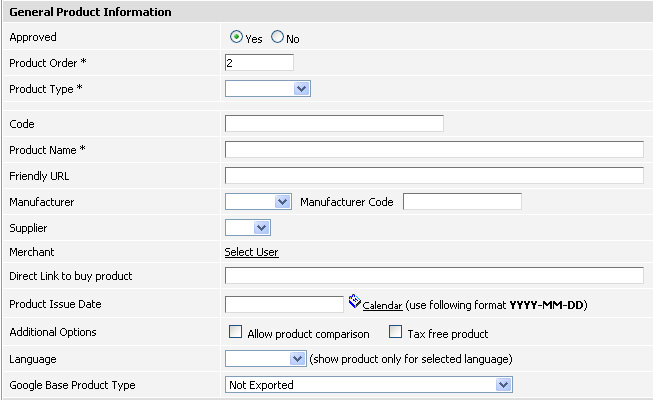Please, see the list of all new features and fixed bugs that were made to all ViArt PHP Shopping Cart releases from version 2.1.1 up to the latest 3.5 version.
18.5.1. General Tab
|
|
On the General tab first of all you can see an option Make this Product available for sales.
 General Product Information Please note there exist other ways for changing order - the Change Products Order and Products links (see section 18.4). Product Type – A product can be classified or grouped as an accessory, bundle, gift voucher, a stand-alone product or you can create your own product type by going to the Products > Product Types section. Code – This may be a stock code or warehouse code. Product Name – This is the actual name of the product. Note, the product names are quite important when it comes to search engine optimization. Some Good Examples of Product Names are Apple iPod Classic 160GB; LG M228WA BZ 22 in. LCD Television, Sony DCR-SR55E Hard Disc Drive Handycam with X25 Zoom. Bad Examples of Product Names: SPECIAL - Introductory Offer - Quick Refill Pack!; LG_LCD Television; Free Offer – Xerox Quick Refill Pack! For All Xerox Phaser 8560 & 8560MFP Printers - HURRY WHILST STOCKS LAST. Friendly URL – This is a user friendly URL. By default if friendly URLs are activated in System > Global settings, the Admin system uses the Product Name as the friendly URL with spaces in the product names replaced by underscores ("_"). Manufacturer – This is where you can choose the available manufacturers for the product by using the drop-down menu. You can create manufacturers by going to this section on the admin – Products > Manufacturers. Manufacturer Code – This could be the SKU or Part-Code or OEM code or the manufacturer code of a product. Supplier - This is where you can set the supplier for that product. To create suppliers go to Suppliers section under Products top menu. Please note, it is also possible to sent notifications for suppliers when their products are purchased. The Supplier Notification can be set in Order Statuses. Merchant - This is where you can select a merchant for that product. In order to be able to select merchants, you need to give rights to add products to some user group. Please see section 85 to learn more about merchant module. Direct Link to buy product - This field is usually used for affiliate purposes as it allows to insert a link to the website where user can buy this product. On clicking Add to Cart user will be automatically transferred to this link if there is any value in this field.. Product Issue Date – You can set the issue date of the product here. For convenience you can use the calendar link which allows to select the day, month and year. Product Issue Date could be used, for example, for New Products Sorting in Products > Products Settings or Products (Latest) block. Additional Options – Allow product comparison – Ticking this checkbox allows to compare different products on the website. The screenshot below shows an example of this feature:  Pricing  Fees & CommissionsMerchant Fee and Affiliate Commission – These fields are used to set the fee or commission which goes to merchant's or affiliate's account when this product is purchased. Note: it will apply to the whole Product List Price if you have not provided the Buying Price in the product details. |
|
|


